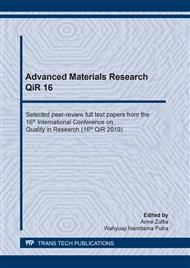[1]
A. Hooijer, S. Page, J.G. Canadell, M. Silvius, J. Kwadijk, H. Wösten and J. Jauhiainen, Current and future CO emissions from drained peatland in south east asia, Biogeosciences, 7, (2010), 1505–1514.
DOI: 10.5194/bg-7-1505-2010
Google Scholar
[2]
C.D. Evans, J.M. Williamson, F. Kacaribu, D. Irawan, Y. Suardiwerianto, M.F. Hidayat and S.E. Page, Geoderma, 338, (2019), 410–421.
DOI: 10.1016/j.geoderma.2018.12.028
Google Scholar
[3]
N. Haris, S. Minnemeyer, F. Stolle and O.Payne (2015, 16 October), Indonesia's Fire Outbreaks Producing More Daily Emissions than Entire US Economy, World Resources Institute, information on https://www,scodev,eu/sites/default/files/201812/www_wri_org_blog_2015_10_indonesia_s_fire_outbreaks_producin,pdf.
Google Scholar
[4]
C. Indriani, in: Sepekan, 66,5 Hektare Lahan Gambut di Riau Terbakar, Kompas,com, information on https://regional,kompas,com/read/2019/01/08/20390451/dalam-sepekan-665-hektare-lahan-gambut-di-riau-terbakar.
DOI: 10.20886/jphka.2013.10.3.327-342
Google Scholar
[5]
R. Boer, Sulistyowati, I. Las, F. Zed, N. Masripatin, D.A. Kartakusuma, D. Hilman and H.S. Mulyanto, H.S. Summary for Policy Makers: Indonesia Second National Communication Under The United Nations Framework Convention On Climate Change (UNFCCC), (2009).
DOI: 10.29171/azu_acku_pamphlet_ge320_a33_s436_2017
Google Scholar
[6]
Emisi Karbon Deforestasi dan Degradasi Hutan Berkurang, (2019, 16 June), Forestdigest, information on https://www,forestdigest,com/detail/267/emisi-karbon-deforestasi-berkurang.
DOI: 10.20886/jakk.2016.13.2.103-125
Google Scholar
[7]
T. Hirano, J. Jauhiainen, T. Inoue and H. Takahashi, Carbon dioxide emissions through oxidative peat decomposition on a burnt tropical peatland. Ecosystems, 12(6), (2009), 873-887.
DOI: 10.1007/s10021-008-9209-1
Google Scholar
[8]
S. Sundari, T. Hirano, H. Yamada, K. Kusin and S. Limin, Effect of groundwater level on soil respiration in tropical peat swamp forests, J. Agric, Meteorol, 68 (2), (2012), 121–134.
DOI: 10.2480/agrmet.68.2.6
Google Scholar
[9]
R. Cao, X. Xi, Y. Yang, X. Wei, X. Wu and S. Sun, The effect of water table decline on soil CO2 emission of zoige peatland on eastern Tibetan Plateau: a four-year in situ experimental drainage. Applied Soil Ecology, 120, (2017), 55–61.
DOI: 10.1016/j.apsoil.2017.07.036
Google Scholar
[10]
H. Dikici and C.H. Yilmaz, Peat fire effects on some properties of an artificially drained peatland, J. Environ Qual, 35, (2006), 866–870.
DOI: 10.2134/jeq2005.0170
Google Scholar
[11]
W. Hao, Y. Ling-Fei, C. Li-Tong, W. Chao and H.E. Jin-Sheng, Responses of soil respiration to reduced water table and nitrogen addition in an alpine wetland on the Qinghai-Xizang Plateau, Chinese Journal of Plant Ecology, 38(6), (2014), 619–625.
DOI: 10.3724/sp.j.1258.2014.00057
Google Scholar
[12]
J. Saputra. Pengujian Beberapa Alternatif Teknik Penanaman Karet Pada Lahan Gambut Laporan Penelitian (Balai Penelitian Sembawa, Palembang, (2015), 7-9.
DOI: 10.22302/ppk.jpk.v36i2.595
Google Scholar
[13]
G.E. Susilo, K. Yamamoto, T. Imai, T. Inoue, H. Takahashi, Y. Ishi, H. Fukami, K. Koizumi and K. Kusin, Effect of canal damming on the surface water level stability in the tropical peatland area, Journal of Water and Environment Technology, 11(4), (2013), 263-274.
DOI: 10.2965/jwet.2013.263
Google Scholar
[14]
J.H.M. Wösten and H.P. Ritzema, Land and water management options for peatland development in Sarawak, Malaysia, International Peat Journal, 11, (2001), 59-66.
Google Scholar
[15]
H. Ritzema, S. Limin, K. Kusin, J. Jaunianen and H. Wösten, Canal blocking strategis for hydrological restoration of degrade tropical peatlands in central kalimantan, indonesia. Catena, 114, (2014), 11-20.
DOI: 10.1016/j.catena.2013.10.009
Google Scholar
[16]
N.A. Kinasih, A. Cifriadi, T.Wijaya, Physical properties and peat lands acid resistance characterization of natural rubber composite based canal blocking, Indonesian Journal of Natural Rubber Research, 36 (1), (2018), 51-64.
DOI: 10.4028/www.scientific.net/msf.1000.173
Google Scholar
[17]
A. Grønlund, A. Hauge, A. Hovde and D.P. Rasse, Carbon loss estimates from cultivated peat soils in Norway: a comparison of three methods, Nutrient Cycling in Agroecosystems, 81(2), (2008), 157–167.
DOI: 10.1007/s10705-008-9171-5
Google Scholar
[18]
N. Khasanah and M. van Noordwijk, Subsidence and carbon dioxide emissions in a smallholder peatland mosaic in Sumatra, Indonesia. Mitigation and Adaptation Strategies for Global Change, 24 (1),(2019), 147–163.
DOI: 10.1007/s11027-018-9803-2
Google Scholar
[19]
N. Wakhid, T. Hirano, Y. Okimoto, S. Nurzakiah and D. Nursyamsi, Soil carbon dioxide emissions from a rubber plantation on tropical peatScience of The Total Environment, 581–582, (2017), 857–865.
DOI: 10.1016/j.scitotenv.2017.01.035
Google Scholar
[20]
Soekartawi. Analisis Usaha Tani, Universitas Indonesia, Jakarta, (1995).
Google Scholar
[21]
J,R,Vinson and R.L. Sierakowski, The behavior of structures composed of composite materials, Kluwer Academic Publishers, Dordrecht, Netherlands, 1993, pp,1-27.
Google Scholar
[22]
A. Cifriadi, Material komposit dalam teknologi barang jadi karet, Warta Perkaretan, 29 (1), (2010), 64-71.
Google Scholar
[23]
A.R. Khaloo, M.R.M. Shooreh and S.M. Askari, Size influence of specimens and maximum aggregate on dam concrete: compressive strength, J. Mater, Civ, Eng,,21, (2009), 349-355.
DOI: 10.1061/(asce)0899-1561(2009)21:8(349)
Google Scholar
[24]
W. Arayapanee and G.L. Rempel, A comparative study of the cure characteristics, processability,mechanical properties, ageing, and morphology of rice husk ash, silica and carbon black filled 75 : 25 NR/EPDM blends, J. App. Poly Sci, 109, (2007), 932–941.
DOI: 10.1002/app.28111
Google Scholar
[25]
S. Fu, X. Feng, B. Lauke, Y. Mai, Effects of particle size, particle/matrix interface adhesion and particle loading on mechanical properties of particulate-polymer composites, Composites: Part B, 39, (2008), 933–961.
DOI: 10.1016/j.compositesb.2008.01.002
Google Scholar
[26]
United States Department of Agriculture, Soil Taxonomy a basic system of soil classification making and interpreting soil surveys (2nd ed,), (Government Printing Office, Washington, DC: U,S, 1999).
DOI: 10.1111/j.1475-2743.2001.tb00008.x
Google Scholar
[27]
U. Silins and R.L. Rothwell, Spatial patterns of aerobic limit depth and oxygen diffusion rate at two peatlands drained for forestry in Alberta, Can. J. For. Res, 29, (1999), 53–61.
DOI: 10.1139/x98-179
Google Scholar
[28]
R.S. Clymo, 1983, Peat, in Ecosystems of the world 4A, Mires: swamps, bog, fen and moor, edited by A, J, P, Gore,(Elsevier, Amsterdam, The Netherlands), pp, 159-224.
Google Scholar


